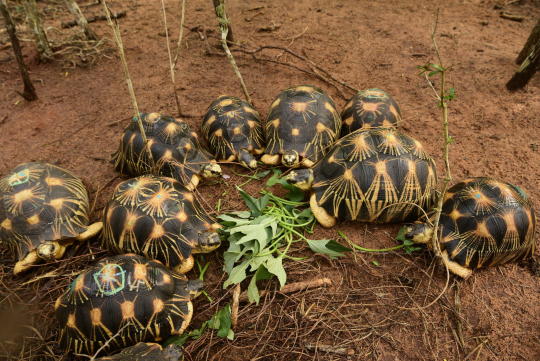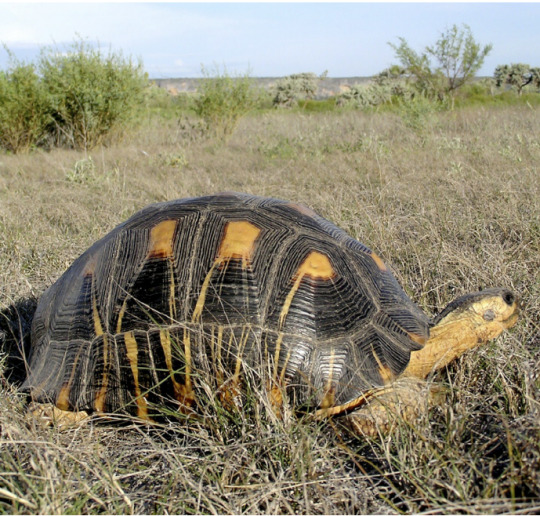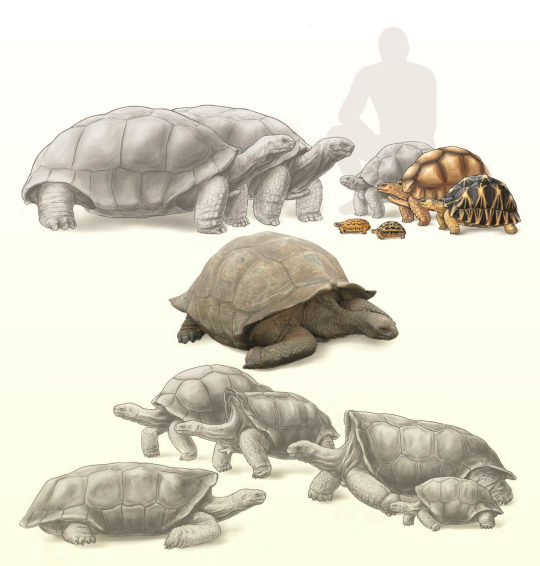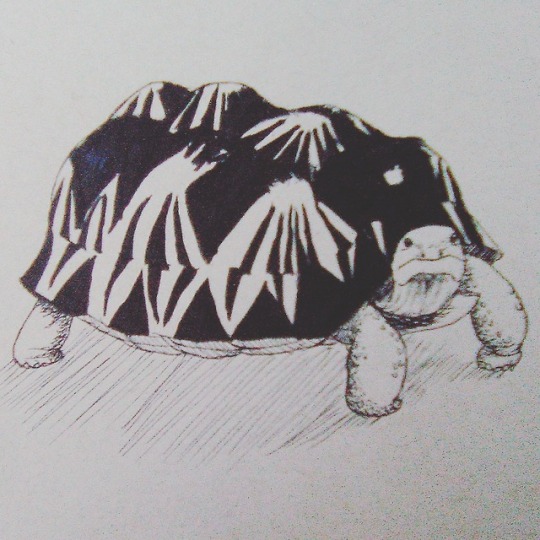#Astrochelys
Explore tagged Tumblr posts
Text

Angonoka or Ploughshare Tortoise (Astrochelys yniphora), family Testudinidae, endemic to Madagascar
CRITICALLY ENDANGERED. (Possibly the most endangered species of tortoise in the world.)
photograph by Andry Fandresena
497 notes
·
View notes
Note
what's the rarest Creature you've encountered? doesn't have to be a frog but any kind of amphibian or perhaps even a non-amphibian
I saw two Astrochelys yniphora specimens in the wild in 2006, while I was in Madagascar on my first trip with my father and a group of other herp enthusiasts. At the time, there were an estimated 800 specimens in the wild. By 2008, the population had dropped to ca 400 individuals, and as of 2018 the species has been considered functionally extinct in the wild, according to Pedrono & Clausen (2018) and the Durrell Wildlife Conservation Trust.

I think this is very probably the rarest creature I have seen in the wild. I guess I have seen some animals in zoos that are also extinct in the wild, or close to it, but I think that doesn't really count. I have also collected the only known specimens of quite a number of frog and reptile species, but those species are probably mostly fine in terms of population numbers, just no-one has checked. And I have seen and handled quite a large number of specimens of extinct species at museums, but that's a very different thing, of course.
#extinction#Astrochelys#Astrochelys yniphora#tortoise#ploughshare tortoise#extinct in the wild#conservation#biology#animals#answers by Mark#anon#anonymous#this is one of the few photos you will ever see of me when I still had long hair#so#enjoy it while you can folks#about me#this is a REALLY depressing post to end the year on#sorry about that
278 notes
·
View notes
Text
Having trouble naming a warlock character? Or perhaps even a sorcerer? Simply make your way to the Wikipedia page for Turtle Genera and let your heart make its choice
🧙🏾♂️ pangshura
🧙🏻♂️pelusios
🧙🏼trionyx
🧙🏻♂️astrochelys
2K notes
·
View notes
Photo




The Radiant Radiated Tortoise
One of the rarest tortoise species in the world, the radiated tortoise (Astrochelys radiata) is only native to the island of Madagascar. They can be found throughout the island, but they are most abundant in the southern part of the island, among the scrub and thorny brush. In addition to their home range, this species has also been introduced to the nearby island of Reunion.
Like all tortoises, the radiated tortoise is an herbivore. Grasses, leaves, and decaying vegetation constitute about 80-90% of their diet, and is supplemented with flowers, fruits, and cacti- particularly prickly pear cacti. Finding food also makes up the majority of their daily activity, as they move around their territories to find fresh growth. A. radiata’s thick shell deters most predators, but reptiles and birds are known to feed on eggs and hatchlings.
The radiated tortoise mates all year round, due to the relatively consistent climate and food supply. When a male encounters a suitable female, he seduces her by bobbing his head and smelling her hind legs. If she’s receptive, he will mount her in a surprisingly noisy, violent affair-- both parties hiss and grunt, and in some cases the female’s shell may crack from the force of the male’s plastron striking it.
If mating is successful, the female lays a clutch of 3-12 eggs in an excavated burrow. These eggs incubate anywhere from 5 to 8 months, depending on the average temperature of the nest. The young that emerge are quite small, only 3-4 cm (1-1.5 in) long and lacking the distinctive patterned dome shell. These tortoises will take 16-20 years to reach their full size and become ready to mate. The lifespan of this species varies widely; most individuals live only 40-60 years, but some have been recorded reaching 188.
A. radiata has a very distinctive look. The shells are extremely curved, and is dark brown or black with a striking yellow star pattern that gives the species its name. The rest of the body is dusty yellow, except for a dark patch on the back of the head. The limbs and tail are also covered in thick, raised scales that offer extra protection against predators and help the tortoise retain moisture. Compared to other tortoise species in terms of size, the radiated tortoise is right in the middle: at their maximum, they can reach 40 cm (16 in) long and weigh up to 15 kg (35 lbs).
Conservation status: The IUCN has classified the radiated tortoise as Critically Endangered, due to habitat loss and overcollection for the pet trade. Wild populations have been Many zoos and conservation programs keep captive populations for breeding and reintroduction.
If you like what I do, consider leaving a tip or buying me a ko-fi!
Photos
Mehgan Murphy
Jackelin Reyna
Rajo Adolphe Landry Andrianiaina
Miguel Pedrono
#radiated tortoise#Testudines#Testudinidae#tortoises#turtles#reptiles#scrubland#scrubland reptiles#tropical forests#tropical forest reptiles#grasslands#grassland reptiles#africa#madagascar#biology#zoology#animal facts
266 notes
·
View notes
Text
The Ploughshare Tortoise: A Jewel of Madagascar's Biodiversity
The Ploughshare Tortoise (Astrochelys yniphora), also known as the Angonoka Tortoise, is one of the most critically endangered tortoises in the world. Native to the island of Madagascar, this species is renowned for its unique shell shape and striking appearance. Its plight has become emblematic of the challenges facing wildlife conservation in Madagascar, a biodiversity hotspot facing immense…

View On WordPress
0 notes
Text
Un antico studio del DNA chiarisce il mondo perduto delle tartarughe giganti dell'Oceano Indiano
In alto – Madagascar, da sinistra a destra: Aldabrachelys abrupta, Aldabrachelys grandidieri, Pyxis planicauda, Pyxis arachnoides, Astrochelys rogerbouri (nuova specie), Astrochelys yniphora e Astrochelys radiata. Al centro – Seychelles granitiche (estinte), Aldabra, Aldabrachelys gigantea. In basso – Mascarene, da sinistra a destra: Cylindraspis indica (Réunion), Cylindraspis inepta,…

View On WordPress
0 notes
Text
Extinct giant tortoise was the 'mammoth' of Madagascar 1,000 years ago
New Post has been published on https://petn.ws/rZYh2
Extinct giant tortoise was the 'mammoth' of Madagascar 1,000 years ago

Native tortoise species of the western Indian Ocean, with living species in color and extinct species in gray. The newly identified Astrochelys rogerbouri is on the top, the third tortoise (in gray) from the right. (Image credit: Drawings by Michal Roessler and photo by Massimo Delfino) At least a millennium ago, a giant tortoise crept […]
See full article at https://petn.ws/rZYh2 #ReptileNews
1 note
·
View note
Photo

Tortue étoilée de Madagascar 🐢 Considéré comme la Tortue la + belle du monde ! Spécimen juste incroyable 🔥 Carapace parfaite et incroyablement lisse ! (Signe d un environnement super adéquat et une alimentation spécifique adaptée ! ) N’hésite pas si tu as des questions concernant le maintien 😉 #tortue #perfect #astrochelysradiata #astrochelys #turtle #reptiles #exotic #sun #wonderful #reptileforinstagram #turtleforinstagram #incredible #tortoise #soleil #reptile #chelonien #luisspack (à Lasne,Ohain) https://www.instagram.com/p/CWxwbI1scbP/?utm_medium=tumblr
#tortue#perfect#astrochelysradiata#astrochelys#turtle#reptiles#exotic#sun#wonderful#reptileforinstagram#turtleforinstagram#incredible#tortoise#soleil#reptile#chelonien#luisspack
0 notes
Text

Angonoka or Ploughshare Tortoise (Astrochelys yniphora), family Testudinidae, endemic to Madagascar
CRITICALLY ENDANGERED. (Possibly the most endangered species of tortoise in the world.)
photograph via: Turtle Conservancy
248 notes
·
View notes
Photo

Radiated tortoise (Astrochelys radiata) in Madagascar
Sheau Torng Lim
79 notes
·
View notes
Photo










Madagascar!, Bronx Zoo (No. 6)
The spider tortoise (Pyxis arachnoides) is a species of tortoise in the family Testudinidae that is endemic to Madagascar and is one of only two species in the genus Pyxis.
The remaining tortoises are found only in south western Madagascar, where they inhabit the spiny vegetation of the sandy coastal areas.
Very little is known about the life cycle of this endangered tortoise, which is believed to live for up to 70 years. Here they feed on young leaves, insect larvae, and even the droppings of larger animals. When the wet season arrives, the dormancy period ends and the tortoises begin to mate. Females only lay one egg when they reproduce, and the egg is incubated for about 220–250 days.
Their trade is illegal in Madagascar, but they are extensively smuggled for food, body parts, and illegal pets.
Source: Wikipedia
#Madagascar!#Bronx Zoo#my favorite zoo#birds#animal#reptile#Astrochelys radiata#detail#close up#New York City#vacation#USA#summer 2019#original photography#tourist attraction#flora#fauna#indoors#Ring-tailed vontsira#ring-tailed mongoose#Galidia elegans#Spider tortoise#behind glass#on the ground#Eastern USA#bird#nature
3 notes
·
View notes
Video
youtube
Radiated tortoise (Astrochelys radiata) [Critically Endangered]
1 note
·
View note
Photo

Radiated Tortoise Astrochelys radiata Source: Here
#astrochelys radiata#radiated tortoise#tortoise#tortoises#reptile#reptiles#animal#animals#nature#wildlife#cool#reptiblr
129 notes
·
View notes
Photo

Welcome to International Turtle and Tortoise Week (April 17-23)! This week I will highlight 7 endangered to critically endangered species, starting with the Radiated Tortoise, Astrochelys radiata. This species is native to southern Madagascar and is classified as critically endangered. Here is my reference plus a little bit of info about these gorgeous tortoises!
#international turtle and tortoise week#ittw#radiated tortoise#astrochelys radiata#my art#traditional#original#this wasnt an art challenge or anything but how can i not do something this week
54 notes
·
View notes
Photo

Happy Tortoise Tuesday!
Radiated tortoises (Astrochelys radiata) for #TortoiseTuesday!
SciArt by Jobin for Histoire Physique, Naturelle, et Politique de Madagascar, Vol. 17 (Reptiles) (1910). View more in the Biodiversity Heritage Library with thanks to Smithsonian Libraries and Archives for digitizing.
#Tortoise tuesday#radiated tortoises#tortoises#herpetology#reptiles#HistSciArt#BHLib#Smithsonian Libraries
158 notes
·
View notes